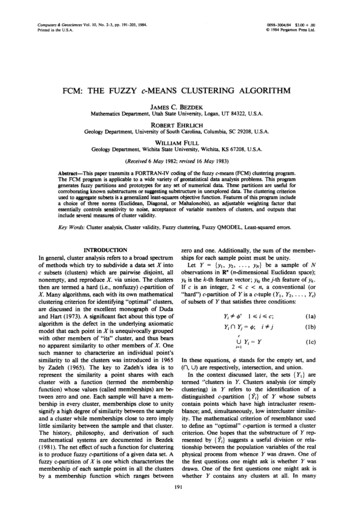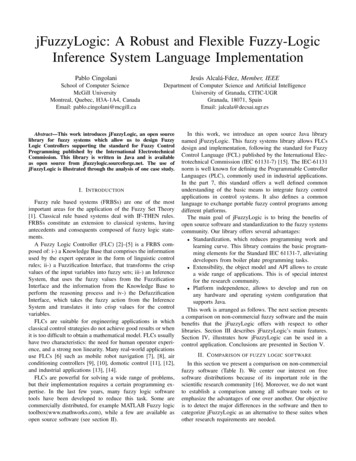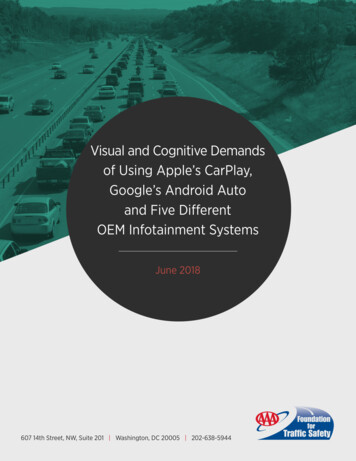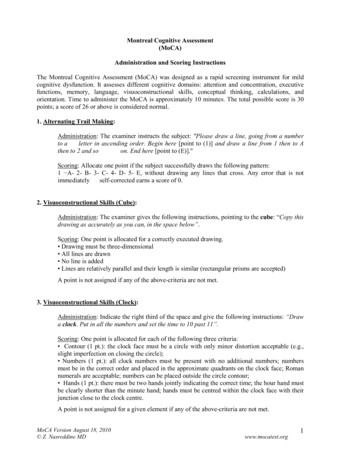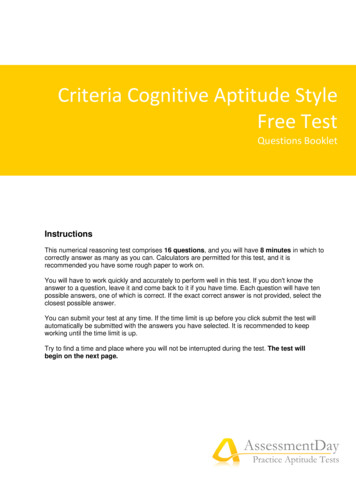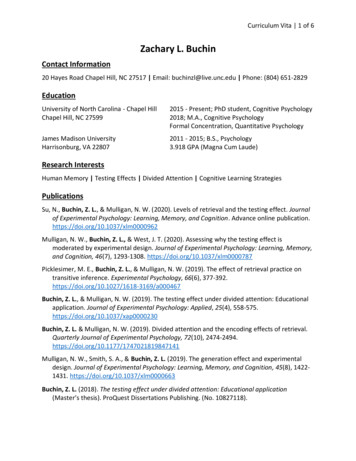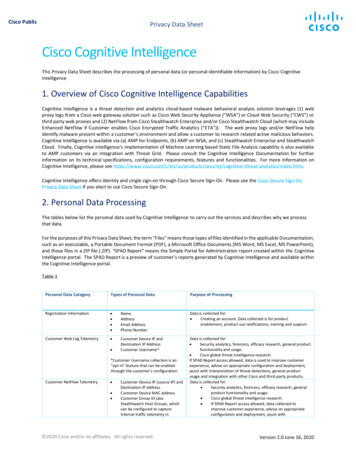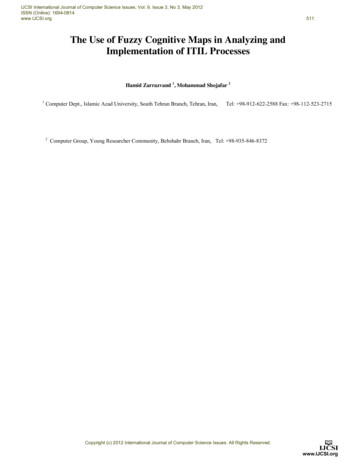
Transcription
IJCSI International Journal of Computer Science Issues, Vol. 9, Issue 3, No 3, May 2012ISSN (Online): 1694-0814www.IJCSI.org511The Use of Fuzzy Cognitive Maps in Analyzing andImplementation of ITIL ProcessesHamid Zarrazvand 1, Mohammad Shojafar 21Computer Dept., Islamic Azad University, South Tehran Branch, Tehran, Iran,2Tel: 98-912-622-2588 Fax: 98-112-523-2715Computer Group, Young Researcher Community, Behshahr Branch, Iran, Tel: 98-935-846-8372Copyright (c) 2012 International Journal of Computer Science Issues. All Rights Reserved.
IJCSI International Journal of Computer Science Issues, Vol. 9, Issue 3, No 3, May 2012ISSN (Online): 1694-0814www.IJCSI.org5122Management is a process to manage the lifecycle ofAbstractInformation Technology Infrastructure Library (ITIL) isseries of best practices that helps Information technologyOrganizations to provide Information technology (IT)services for their customers with better performances andquality. This a rticle is looking for a way to implementITIL in an organization and also using Fuzzy CognitiveMaps (FCM) to model the problem for betterunderstanding of environment. ITIL helps to improve theperformance of IT services in order to g ain businessobjectives and Fuzzy Cognitive Maps will help to modelthe problem of nee ding ITIL processes for thoseobjectives. First, it defines the concept of FCM and ITILin two separate sections and then, it will describe therelationship and the w ay that FCM helps to implementITIL. The paper will measure the cost of service supportthatis de pendedonthemetricslikechangesAuthorization Degree, Process Oriented activities degree,Response time and Interrupt time.This paper will be used as a part of gap analyzes step inimplementing ITIL in each organizations.Keywords: Fuzzy Logic (FL), Fuzzy Cognitive Maps(FCM), Fuzzy Relational Maps ( FRM), InformationTechnology (IT), Information Technology InfrastructureLibrary (ITIL)unwanted events in the environment.As a matter of fact, today the biggest challenge for ITmanagers is to answer this question that how should theyunderstand the environment and c ontrol all the e lementswith less costs and time? To gain this goal, implementingIT frameworks and trying to match business goals with ITObjectives is a common way.This paper will define what FCM (Fuzzy CognitiveMapping) can do to help IT Managers to d esign servicesbase on their assets and Frameworks. It can provide a wayto visualize the problem of m anaging services in ITEnvironment and le t managers to solve t his issue with abetter understanding of their environment; Hence, it isgoing to assess the advantage of using FCM to implementITIL framework in order to achieve business goals fororganization, also, it will answer that how ITIL can help tofind the best way of im plementing ITIL baseonorganization objectives?In order to achie ve all the objectives which arediscussed above, this paper is going to explain those indifferent sections. In Next Section, it defines ITILdisciplines and structure. FCM in real world described inSection 3. I n Section 4, the paper approach the us ing ofFCM/FRM to implement ITIL and the rules will bedepicted. Then diagrams and models of proposed methodbased on “cost of service support parameters” will be1. IntroductionIn these years the new challenge for IT companies is tomanage the variety of se rvices with an appropriatemethodology or fram ework. Thus, to achieve this goal,several IT managers looking for a standard way to managetheir services centrally and try to reduce the impact of ITServices interruptions in organizations.There is a popular framework for managing IT serviceswhich is termed ITIL (IT Infrastructure Library) and wasillustrated. Finally, In Conc lusion part, it descr ibed thegoals and future view of ITIL clearly. Hence, in the nextpart ITIL disciplines will be explained.2. Information Technology Infrastructure LibraryITIL is a set of concepts and practices for velopment and IT operations.published by OGC (Organization Governance Commerce)ITIL gives detail descriptions for IT processes andin 1990. ITIL version 2 was released in 2001 and version 3provides comprehensive checklists, tasks a nd proceduresin summer of 2007 [1].that any IT or ganization can adjust to its r equirements.ITIL is the most popular framework for managingITIL was published as series of books; each covers an ITInformation Technology services [2]. It defines stand ardmanagement topic. The names ITIL and IT Infrastructureprocesses for ma naging services, for exam ple IncidentLibrary are registered trademarks of the United Kingdom'sOffice of Government Commerce (OGC). It cons ists ofCopyright (c) 2012 International Journal of Computer Science Issues. All Rights Reserved.
IJCSI International Journal of Computer Science Issues, Vol. 9, Issue 3, No 3, May 2012ISSN (Online): 1694-0814www.IJCSI.org513b. Deming Cycle and CSI Modelpublications giving guidance on the provision of QualityIT Services, and on the Processes and facilities needed tosupport them. ITIL has three foundation concepts:1) Service: A Service provided to one or moreCustomers by an IT Service Provider.2Figure 1 illustrates a view of ITIL V ersion 3 ProcessDiagram.2) Service Provider: A Service Provider thatprovides IT Services to Internal Customers orExternal Customers.3) Costumer: Costumer is a one who consumes theservice.ITIL version 3 has five core disciplines and more than15 disciplines which are included in core discipline.Below is the list of disciplines:1. ITIL Service Strategya. Definition of Business ServiceRequirementb. Determination of Market Space, ITPolicies & Strategiesc. Specify of Service Portfoliod. Demand Managemente. Financial Management2. Service Design [6]a. Service Level Managementi. Service Catalog Managementii. Supplier Managementb. Availability Managementc. ITSCMd. Capacity Managemente. Information Security Management3. Service Transitiona. Change Managementb. Service Asset and ConfigurationManagementc. Knowledge Managementd. Release and Deployment Management4. Service Operationa. Functionsi. Service Deskii. Operation Managementiii. Technical Managementiv. Application ManagementLifecycleb. Processesi. Event Managementii. Incident Managementiii. Request Fulfillmentiv. Problem Managementv. Access Management5. Service Continual improvementa. 7-Step Improvement Processi. Define what you shouldmeasureii. Define what you can measureiii. Gathering the dataiv. Processing the datav. Analyzing the datavi. Presenting & using theinformationvii. Implementing corrective actionFigure 1: ITIL V 3 Process Model [8]3. Fuzzy Cognitive MappingThis section is going to define the concepts of F CMand its values. FCM visualize the problem and clarify it tounderstand the whole problem with diagrams of graphs.As a matter of fact, this concept looks for a directed graphto show the problem when it becomes hard to understandin usual methods. Here, there is a very importantdefinition:“An FCM is a directed graph with concepts likepolicies, events and etc. as nodes and causalities as edges.It represents causal relationship between concepts “[3, 4]Let’s take a detailed look at the concept, In FCM thesedefinitions existed: When the nodes of the FCM are fuzzy sets thenthey are called as fuzzy nodesFCMs with edge weights or causalities from theset {–1, 0, 1} are called simple FCMsThe matrix E be defined by E (eij) where eij isthe weight of the directed edge E is called theadjacency matrix of the FCM, also known as theconnection matrix of the FCMAn FCM with cycles is said to have a feedbackWhen there is a feedback in an FCM, i.e., whenthe causal relations flow through a cycle in arevolutionary way, the FCM is called adynamical systemCopyright (c) 2012 International Journal of Computer Science Issues. All Rights Reserved.
IJCSI International Journal of Computer Science Issues, Vol. 9, Issue 3, No 3, May 2012ISSN (Online): 1694-0814www.IJCSI.org Finite number of FCMs can be combined togetherto produce the joint effect of all the FCMsMoreover, this section clarifies the properties andFRM.5143There are different types of expert and aspects tocreate the FCM, therefore, in this situation definition ofdifferent FCMs and combined them as one will be done inEq. (1).3.1 Properties and modelsFCM is a collection of classes which is drawn by circleor oval and casual relations between them. The dire ctedF FiAlso, it can uses fuzzy sets for the causes that results indestination nodes, for exa mple increasing the po pulationwill increases unemployment with 0.8 rate and etc.edge eij from causal concept Ci to concept Cj measuresHere, another example of FCM to model and analyzehow much Ci causes Cj. FCMs are used to model manybusiness performance assessment which is so cl ose to thevarieties of problems like political, economic, social,subject of this paper. It is illustrated in Figure 3 [5].organizational management and etc.For this k ind of pro blems, a model w as proposed byThe edges eij take values in the fuzzy causal interval [–Kardaras and Mentzas which is called Impact Analysis1, 1]. eij 0 indicates no causality, eij 0 indicates causalModel (IAM). A part of IAM is to analyze the Informationincrease Cj increases as Ci increases (or Cj decreases as CiSystem or IT affect on business.decreases). eij 0 i ndicates causal decrease or nega tivecausality. Cj decreases as Ci increases (and or Cj increasesas Ci decreases). Simple FCMs have edge values in {–1, 0,1}.In FMC, it is possible to pass a state vector in order tofind a second node, which will be resulted of the first nodethat passed the vector. For example on Figure 2 if it passesvector (1, 0, 0, 0, 0) from n ode c1 then, it wi ll create aFigure 3: FCM Model-2cycle between c1 and c5 which means increasing inpopulation will increase unemployment c5 is termed as afixed point. Hence, you can pass a vector for each node tofind the fixed points.Figure 4 is an example of effects that have impact onIT opportunities and threats to change the performance ofbusiness.Figure 2: FCM Model -1In the Figure 2, there is an example of FCM modelwhich represent A Socio-economic model constructedFigure 4: FCM Model-3with Population, Crime, Economic condition, Poverty andUnemployment as nodes or concept [11].Copyright (c) 2012 International Journal of Computer Science Issues. All Rights Reserved.
IJCSI International Journal of Computer Science Issues, Vol. 9, Issue 3, No 3, May 2012ISSN (Online): 1694-0814www.IJCSI.org5154FCM will be used to show how policies can affect on the3.2 FRMHere, it will show a br ief view of pro blem in FRM;hence, let’s take a quick look on this concept. FRM let usto make two disjoint groups of all the nodes (for examplegroup A and B with domain space and a range space whichare disjoint in the sense of concepts) and then it can resultgroup B from A, in order to find the answer if some nodesexample in Figure 5. Th e Table 1illustrated the Groups A and B. Group A is DiUsually, when all concepts are in the same se t, theFCM model is going to use, but, if the re are concepts indifferent sets, it is better to use FRM4. Implementing ITIL Using FCM/FRM (Approach)First, it is required to kn ow some templates of ITILand the approaches of the m; this will help to understandof A happens which situation will resulted in group B.There is anmain goal/strategy of implementing ITIL.thatconsiders teaching states and Group B Ri stands for Rules.the relation of disciplines better, and then categorize ITILprocesses into groups [9].In the next figure it w ill show some reasons tointroduce the a pproaches (it means the reasons cause toTable 1: Group A results Group BGroup A(Di)choose an a pproach). Hence, let t ake a quick look at anGroup B(Ri)D1Teaching is goodR1Good StudentD2Teaching is poorR2Bad StudentD3Teaching is mediocreD4Teacher is kindR3Average StudentD5Teacher is harsh [or rude]example which shows the relations between them that isillustrated in Table 2.Table 2: Relationships between reasons and approachesReasonsApproachesCostBare necessitiesThis paper will use FRM to create a relationshipNo Customer SupportOrganic growthbetween ITIL processes and inputs of FCM system (FuzzyISO 2000 LimitationsService supportblack box inputs) to show how implementing thoseTime ConstraintsService deliveryprocesses will affect the results of FCM. It does it in t hisOwnershipOld versionway because ITIL processes can not affect directly onRunning out of steamOld version output and FCM’s output has been affected by inputs thatToo ComplexLifecyclerelated to those processes.Oldversionsimplemented3.3 FCM vs. FRMFCM is a graph (directed graph) that consists of twogroups first one is concepts group (Nodes) and the secondone is causalities (Edges). FCM uses ed ges to sh ow therelationship between concepts and th ose concepts aresomething like policies, events and etc.FRM is a technique to simply show how some workscan result some effects (variables are in a fuzz y sets). Itusually uses two groups to dra w a diagram or table inorder to sh ow how the first group can cause the secondalreadyContinual service improvementService operationService ownershipBest practicesCreate templateIn this example the reason for implementing servicesupport is costs (cost is the main reason of implementingITIL service support for an organization).4.1 Service Support approachgroup. FRM is not a graph like FCM; it c onsists of twoThe main target of ITIL implementation in this paper issets that relate together. Indeed, this pa per used FRM toto use the disciplines for supporting IT services. It try todemonstrate how implementing ITIL Processes can affectuse those discipline that is related to support and it is noton the FCM concepts (organization policies) and thenfor those which are related to service design or serviceCopyright (c) 2012 International Journal of Computer Science Issues. All Rights Reserved.
IJCSI International Journal of Computer Science Issues, Vol. 9, Issue 3, No 3, May 2012ISSN (Online): 1694-0814www.IJCSI.org5165strategy etc; thus, the ser vice support related processeswill be picked up from a methodology that is explained in“ITIL lite : a road map to full or partial ITILimplementation”For implementing ITIL as a service support approach itis needed to implement some essential processes of ITIL.These processes are listed below:1.2.3.4.5.Incident Management[10]Problem ManagementChange Management[7]Service Asset and Configuration ManagementService Desk (Function)Figure 5: Example of relations for ITIL4.2 FCMThe processes which are known as service supportprocess group are the most famous ones that areimplemented in most IT organizations in a way ofapproaching ITIL. Hence, let’s take a look at therelationships between them in Figure 5.with all other processes and the fact that having a powerfulteam of service desk and Incident management helpitpossible. After Incident management Service Asset andConfiguration management is the ne xt important processthat helps organization for their a pproaches. Changemanagement and P roblem management are needed tocomplete the chain of diagnosing the interrupted services,which they were started from Incident managementworkflow. Finally, service desk is a core site of handlingincidents which are created by end users, and it works as afunction for IT department.understand the affect of ea ch process on the w ay ofimplementing service support approach,But before explanation, it is required to define theFigure 5 sh ows how Incident management interactsorganizations to get to the ir approach as soon asNow, let’s define how the using of FCM helps topotential causes of using service support approach:1. Decrease the cost of implementation2. Quick response to end user3. Fix interrupt as soon as it possible4. Changes done by authorization5. Process oriented system6. Everything and each activities recordedHence, let see what happens in a simple FCM diagramfor those causes in Figure 6. F igure 6 show s therelationships between the nodes that contain the causesandgoalsof implementing,forexample,increasing/decreasing in respo nse time will results inincreasing/decreasing the cost of su pport and a lsoincreasing/decreasing the numbers of recorded events willdecrease/increase the response time and so on.Copyright (c) 2012 International Journal of Computer Science Issues. All Rights Reserved.
IJCSI International Journal of Computer Science Issues, Vol. 9, Issue 3, No 3, May 2012ISSN (Online): 1694-0814www.IJCSI.org5176It means increase in response time will result increasein cost. And in another example if it pa sses C1 as vec tor(0, 0, 0, 1, 0, 0), for process oriented, the result is Eq. (3).C1E (-1,-1,-1,0,0,1) (0,0,0,1,0 ,1) C 2C2 E (-2,-2,-1,0,1,1) (0,0,0,1,1,1) C4 C3(3)When passing C1 as vector (0, 0, 1, 0, 0, 0) forFigure 6: ITIL Service Support approach FCM Model -1Interrupts the result is Eq. (4).C1 E (0,1,0,0,0 ,0) (0,1,1,0,0 ,0) C 2C 2 E (0,1,0,0,0,0) (0,1,1,0,0,0) C 3 C 2Here, is the adjacent matrix of goals FCM on Table 3.(4)After illustrating the relationships let redraw theTable 3: Adjacent MatrixResponse TimeCostInterruptdiagram with the fuzzy sets re lationships that areknowledge based relations and is shown here: (It uses 10nted“too little ”0.1”, little ”.03”, usual ”.05”, much ”0.7”,very much ”0.9”” for the rate of memberships in set) inFigure 7.ProcessOrientedRecordingAuthorizationFor the adjacent matrix, passing a vector (1, 0, 0, 0, 0,0) to find a fixed point and a circle in Eq. (2).Figure 7: ITIL Service Support approach FCM Model -2And, after replacement of “the rate of memberships” in theC1 E (0,1,1,0,0 ,0) (1,1,1,0,0 ,0) C 2C2 E (0,2,1,0,0,0) (1,1,1,0,0,0) C3 C2adjacent matrix table 3 will be converted to table 4.(2)Copyright (c) 2012 International Journal of Computer Science Issues. All Rights Reserved.(2)
IJCSI International Journal of Computer Science Issues, Vol. 9, Issue 3, No 3, May 2012ISSN (Online): 1694-0814www.IJCSI.org5187Table 4: Adjustment Matrix-DiffusificationResponseTimeResponse izationAlso using fuzzy black box engine, to ca lculate therules, can make some fuzzy decision box rules. ngationted0.700.70.0.9000000000000-0.3000.70.ITIL was tested on PC with Notebook Core 2Duo1.7GHZ, 2.0 Giga Byte Ram with Windows XP OS andprogrammed with Netbeans 6.8 ( Java 1.6) Software andEdition Software.There are some experimental rules that can help to0000understand the core of fuzzy black box. These are elicitedfrom C1 (Interrupt Time), C2 (Response Ti me), C3(Process Orientation Rate) and C4 (Authorized Change0The execution code of servic e support approach onthe diagrams are achieved on Fuzzy-tech 5.5 professional5-0.1that problem in the next part as performance evaluation.4.3 Performance Evaluation (Fuzzy black box)-0.5based on the proposed method this paper will be illustrated000.507Finally, it is better to find an optimum FCM diagram.Rate) that mentioned before, showed in Table 5.Table 5: Rules Considered for Test based on C1, C2, C3, C4IF C1 is little and C2 is little and C3 is normal and C4 is much CostTo catching that goal it is required to keep importantwill be littlenodes and clear other no des (by their rate), so choosingIF C1 is much and C2 is much and C3 is little and C4 is little Cost willcost as a main output and “authorized changes”, “interruptbe muchtime”, “response time”, “process oriented” as main inputIF C1 is normal and C2 is normal and C3 is much and C4 is normalcreate another view of diagr am. This opt imum model isCost will be normaldesigned base on best practices and ex periences. TheIF C1 is normal and C2 is normal and C3 is little and C4 is normalfollowing clearly shows it in Figure 8.Cost
ITIL in an organization and also using Fuzzy Cognitive Maps (FCM) to model the problem for better understanding of environment. ITIL helps to improve the performance of IT services in order to gain business objectives and Fuzzy Cognitive Maps will help to model the problem of nee d

